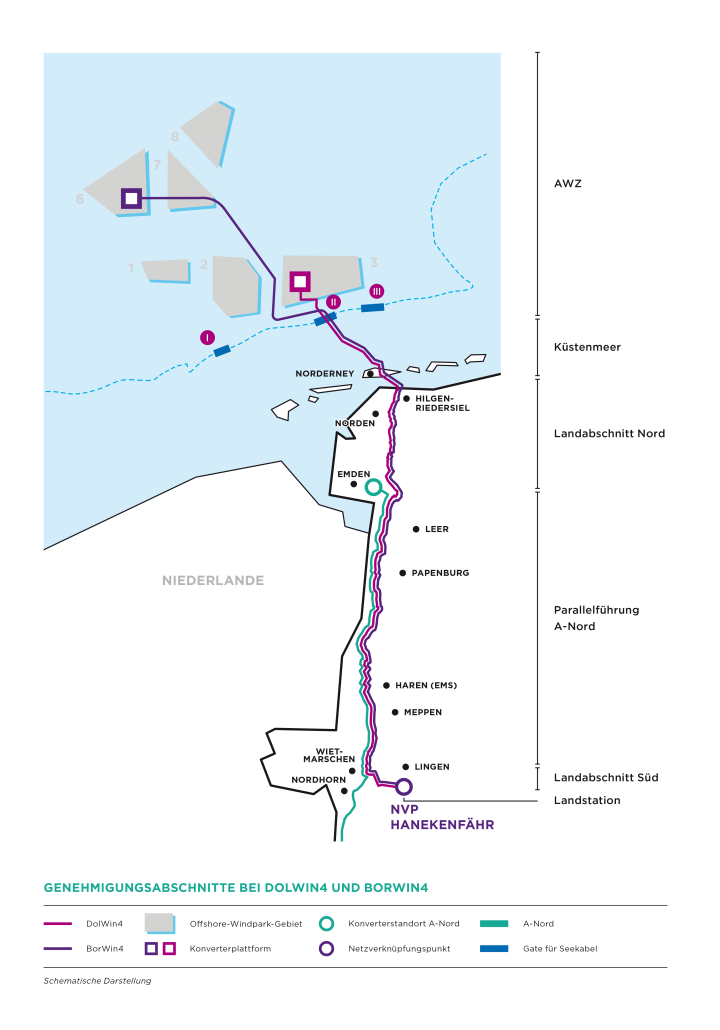Multi-Step Approval

Exclusive Economic Zone
All grid expansion projects are subject to legally required approval procedures – so too the offshore grid connection systems DolWin4 and BorWin4. The wind farms are located in the so-called “Exclusive Economic Zone” (ausschließliche Wirtschaftszone, AWZ, in German). This zone extends up to twelve nautical miles – around 22 kilometres – from Germany’s North Sea coast and falls under the jurisdiction of the Federal Maritime and Hydrographic Agency (BSH). The first step on the way to approval is regional planning (Raumordnung). This is for the most part implemented through the Site Development Plan (Flächenentwicklungsplan). Furthermore, a planning approval procedure (PFV, from the German “Planfeststellungsverfahren”) must be conducted by the BSH. The Agency also issues the construction and operating permits required for the converter platforms and cables in the Exclusive Economic Zone.
Coastal Waters
The coastal waters extend a total of twelve nautical miles from the coast into the North Sea. The State (Land) of Lower Saxony is legally responsible for this area with regard to the issue of permits. The Weser-Ems Regional Development Office has already defined a corridor in the Regional Plan on behalf of Lower Saxony. The Norderney II Corridor can also be used for DolWin4 and BorWin4. In December 2021, we received the two planning approval decisions from the Lower Saxony State Authority for Road Construction and Transport, which is responsible for this area. Construction work scheduled for 2022 on the first boreholes to cross the island of Norderney has already been completed. Further drill holes will follow in the summer of 2023 as planned.
Land Sections
For those sections of DolWin4 and BorWin4 on land, we will lay some 155 kilometres of underground cable between Hilgenriedersiel and Hanekenfähr (Lingen). We are searching for a cable route for these lines that is as space-saving and as environmentally compatible as possible, ideally one that follows the course of existing linear infrastructures such as motorways or gas pipelines. Here, too, we have divided the route into several sections:
The first section runs from the coast to the Emden area. Here we can use a corridor that the administrative district of Aurich has already identified in the Regional Plan. Consequently, the northern-most section of the onshore route will require no more than a planning approval procedure by the Lower Saxony State Authority for Road Construction and Transport.
For the section that will run from Emden to the Lohne area, we are already planning another underground DC cable project that goes by the name of A-Nord (Emden–Osterath). We will be bundling the A-Nord, DolWin4 and BorWin4 projects. In order words, we are planning A-Nord and the two offshore grid connection systems together in a joint approval process and will also be constructing in parallel. In this way, both the impact on the soil and landscape and the economic costs can be reduced.
From the Lohne area onwards, A-Nord and the two offshore projects will go their separate ways. For the final section of the route to the converter station located in the Lingen area, the responsible authorities have waived the requirement for a regional planning procedure. We were able here to demonstrate in a detailed feasibility study that laying underground cables is compatible with the objectives and principles of the regional plan. As a result, a planning approval procedure by the State of Lower Saxony is the next approval step for this section as well. The location in the Lingen industrial park has proved to be the preferred location for the two converters. We are working to get this location approved as part of a separate procedure in accordance with the German Federal Immission Control Act.